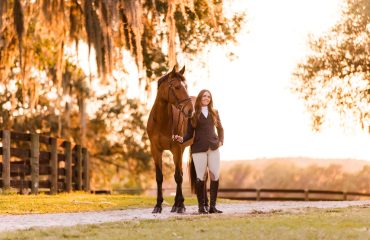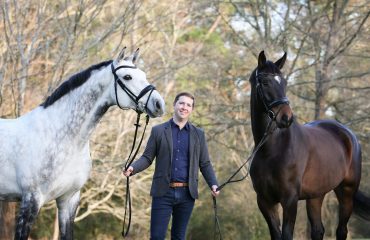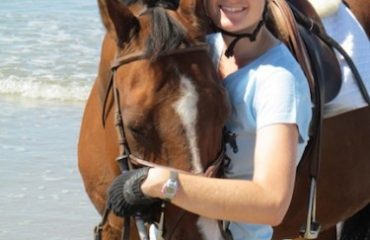By Sydney Masters Durieux

While visiting the Loire Valley, you can take a castle-to-castle ride and perhaps visit the Montsoreau castle, which looks stunning at night.
The World Equestrian Games in Normandy, the European Championships in Chantilly, the Nation’s Cup in LaBaule and the Gucci Masters in Paris: There’s no shortage of top-notch international competitions on the calendar in France each year.
But visitors don’t need to stick to a schedule to find equestrian offerings in France. In fact, the Loire Valley highlights the horse in one way, shape or form year-round. Whether you want to see royal stables or a jousting tournament, trek from castle to castle on horseback or try your hand at the awe-inspiring, wild game of pony ball, it can be done in the valee des rois (valley of the kings).
The River Loire (la Loire) is the country’s longest, most impressive river, running from Sancerre to the sea. Vineyards and fruit orchards cloak its banks, from which the Cher, Indre, Loir and other rivers flow. Fortresses and castles built from luminous pierre stone reflect in its waters and evoke the brilliance of a bygone era, bringing the history of the region to life.
Loire Valley Activities
Of course, food and wine is first on most people’s agendas, but activities abound in la Loire. You can literally follow in the footsteps (or hoof prints) of the region’s most beloved heroine, Joan of Arc (Jeanne d’Arc), survey the chateau-studded landscape from a hot-air balloon, stroll through forests filled with wild mushrooms and animals, explore subterranean troglodyte dwellings or take a relaxing tour on a river boat. The area plays host to countless events, from world-class jazz festivals and medieval fetes to high-caliber equestrian competitions.
There’s no place like the Loire Valley when it comes to castles. Each offers something special, from fabulous flying machines invented by Leonardo da Vinci at Chateau du Clos Luce, to centuries-old graffiti carved by imprisoned Knights Templar in Chateau du Chinon, and a 1.5-ton cage that held a Cardinal — who had fallen out of favor for 11 years — in the donjon at Chateau de Loches. You can enjoy breathtaking son et lumiere (sound and light) shows at Chateau de Chononceau, dress in period costume and paddle around the moat at Chateau d’Ilette, or de-stress with a yoga class on the grounds of Chateau de Candes in Candes St. Martin.
If you’d like to create a horse-inspired itinerary, the first stop on the agenda is Chateau de Chambord, the Loire Valley’s largest, most impressive castle. The handiwork of three kings — François I (ruled 1515-47), Henri II (ruled 1547-59) and Louis XIV (ruled 1643-1715) — it was originally built as a hunting lodge and dedicated to la chasse (the hunt). There are 440 rooms, a 56-meter-high grand staircase and over 400 salamanders (the sign of the King) of a particularly fierce-looking disposition on the stone-sculpted, coffered ceiling.
Visitors will feel like they’ve been transported back in time as gallant riders — dressed in period attire — trot by or school their high-stepping mounts on the grounds in front of the castle. For a real show, head to the castle’s stables for a fun, colorful 45-minute Spectacle d’Art Equestre performance, with “dancing” horses, trick riding and demonstrations of old-style equitation in all its splendor.
Chateau de Cheverney
Not far away is Chateau de Cheverney, which may seem vaguely familiar to some as it was the inspiration for the Marlinspike Hall in the comic-strip Tintin. The castle sits on 2,000 hectares, and one can explore the forest and lake by electric car or boat. The outbuildings include an 18th century Orangerie, where Leonardo da Vinci’s “Mona Lisa” was hidden during World War II. As was the custom among nobility of past centuries, the owner of Cheverney, viscount de Sigalas, hunts stags (not foxes) with his pack of hounds that live at the castle. There are 90 dogs, most a cross between English fox terriers and French poitevins, which range in age from 7 months to 7 years. During the off-season, the hounds, which are much larger than American and English hunting hounds, placidly lounge about the enormous kennels and outdoor enclosure spaces, but they’re a full-on working pack from September through March. Visitors can see them departing into the Foret de Cheverney every Tuesday or Saturday to hunt deer.
There are impressive stables to be found throughout the Loire Valley, as every working castle needed them for travel, work and pleasure. The barn at Chateau D’Usse, the inspiration for the fable “Sleeping Beauty,” is worth a peek as it houses horse carriages and even a wooden dog cart from different eras. Chateau de Montpoupon’s stables include large box stalls and tack rooms filled with an array of saddles and bridles polished to perfection. At Chateau du Riveau, where Joan of Arc stopped to change horses before attacking and defeating the British in Orleans, guests can take a tour of the historic stables or enjoy outdoor activities like real-life knights-in-armor jousting matches.

For 17th century action, head to Richelieu during the town’s annual Renaissance Fair, where the streets are filled with sword fighting and blacksmiths.
For some 17th century action, head to Richelieu during the town’s annual Renaissance Fair, where the streets are filled with sword fighting and blacksmiths can be found forging horseshoes and weapons. Dandy, decked-out riders perform swashbuckling moves from horseback, including shooting while hanging off the side and standing to fire at a full gallop.
The Capital of the Horse
No trip to La Loire would be complete without heading to The Capital of the Horse — Saumur. The fortified Chateau de Saumur houses the Musee du Cheval (Horse Museum), which recounts the history of riding from antiquity to the 20th century. Equestrians are sure to be impressed (or perhaps appalled) by some of the tack on display, which includes ancient saddles, plated nosebands and armor, handcrafted stirrups, and a variety of ancient bits from simple snaffles to massive pieces of hardware that could stop a truck in its tracks!

American rider and actress Alex Ladove (and former Sidelines cover girl) joins Arnaud Lievre at Butet Sellier.
Just out of town, you can get your shopping fix by stopping at one of the many tack shops en route. While you’re at it, you can swing by and get measured for a custom saddle at France’s famed Butet Sellier, the official saddle makers for the elite cavalry unit Cadre Noir, and the Ecole National d’Equitation located just up the road. The prestigious equestrian school accepts no more than 200 students per year who hope to leave as qualified instructors after 10 months of intensive training. Not long ago, America’s “King of Equitation,” George Morris, was presented with their highest honor: the Golden Spurs.
Owners, trainers and barn managers alike will appreciate the overwhelming size of the school venue, which includes 50 stables, 15 outdoor arenas, 50 km (31 miles) of sand gallops and 400 horses cared for by 70 grooms. Taking care of so many mounts on a daily basis would be overwhelming for most, even at the biggest show barns in the United States. Technology helps with overhead pipes automatically dropping feed and water into each horse box four times a day. The stalls, bedded with straw, are done the old-fashioned way, but the waste is removed via an underground conveyor belt that dumps 10 tons daily onto the manure mountain, which is then recycled by the surrounding mushroom farms.

Visitors to France have the opportunity to enjoy the Cadre Noir — where the riders dress in black cap and jacket.
Cadre Noir
You can watch the Cadre Noir — dressed in black cap and jacket, gold spurs and three golden wings on the whip — put their horses through their paces daily or enjoy a scheduled performance held in Europe’s largest indoor arena. This is far from your average horse show; the horses do airs above ground and other acrobatic feats such as the 45-degree hind-kick of the croupade, the tightly tucked front legs of the courbette and the demanding, four legged leap of the capriole.
Of course, if you want to saddle up while visiting the Loire Valley, there are options. You can sign up for a multi-day, castle-to-castle ride or stay at a gite, chambre d’hote, or hotel chateau that offers pleasure riding, polo or intensive programs. There are also numerous club hippiques, which offer trail rides and outings as well as lessons for all ages and levels. They may not speak English, but as we all know, “horse” is an international language!
About the writer: Sydney Masters Durieux, an avid equestrian and veteran competitor, is a freelance publicist and writer who grew up riding and showing at Stillmeadow Farm in Stonington, Connecticut. She graduated New York University and decided to combine her love of horses with her passion for public relations. During her career, Sydney has represented many world-class show jumping veterans, up and coming equestrian talents, leading trainers and stables as well as internationally recognized horse shows. Sydney lives with her husband, web designer Arnaud Durieux, and their West Highland White Terrier “Angus” between their home in the Loire Valley in France and their apartment in New York City.
Photos by Sydney Masters Durieux














